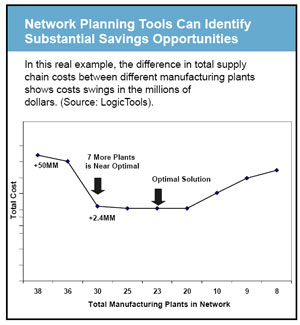 The Six Steps to Supply Chain Network Planning Success The Six Steps to Supply Chain Network Planning Success
The six steps summarized below can be used with any supply chain network optimization software, and have the advantage of making the entire process more “visible” and understandable, according to the authors.
- Orient the project: Ensure the project’s objective and scope are clearly defined and understood by both management and project team members. Determine what parts of the company’s supply chain can actually be “modeled.” Identify and rank the most important supply chain design issues and decisions.
The result of this step is a foundation for the project and clearly defined objectives that are shared among key participants.
- Define the variables: What are the key elements of the supply chain that must be considered for the project? What are the key assumptions and constraints? These include such basic areas as defining the locations and transportation lanes that are in scope, what products and their hierarchies will be modeled, how demand is defined and how long it will be considered, how manufacturing or distribution capacities are defined, what time buckets will be used for analysis, what units of measure will be the basis of the analysis, etc.
A simple example: what are the minimum and maximum hours a given manufacturing line can operate per week?
This step also includes developing baseline “formulas” for how these variables interact or perform; for example, how will potential transportation costs actually be calculated?
The result of this step is a basic model of the supply chain and its variables, constraints and performance factors.
- Analyze the sensitivities: Is the basic model that has been constructed in step 2 accurate and usable? The basic model that has been constructed is run through the optimization software to look for inconsistencies and violations of constraints. Missing or faulty details (e.g., transportation lanes or product families are absent) are also identified.
Through an iterative process, such problem areas are corrected. The model continues to be tweaked until it can accurately represent the current network performance over some timeframe. That accurate modeling of the current network gives the team confidence in the analysis of potential new network configurations.
The result of this step is a validated model that serves as the basis for additional optimization.
- Create scenarios: What steps could be taken to change the network and its performance? For example: add or remove manufacturing and distribution locations; change transportation or sourcing strategies, change customer delivery assignments, etc. Clearly, today globalization is a key element of these considerations for many companies.
It’s impossible to look at every possible idea. Here, you whittle the list of potential network changes down to some manageable list of alternatives, and use the software tool to evaluate the impact of these alternatives on cost, service, or other variables. This effort will also show what changes are important drivers of results and which are not. If under any scenario the network still looks best with three distribution centers, for example, further analysis of this variable is obviously not productive.
Senior executives tend to move directly to the “Cost Estimate” section of each scenario, so plan and manage accordingly.
The result of this step is the elimination of many network options and a shorter list of likely ones.
5. Evaluate the alternatives: The most likely scenarios are now looked at in more detail, considering both hard cost and more intangible factors (for example, how difficult different plans might be to implement, or the level of supply chain flexibility – the lowest cost plan could also be the most rigid).
The cost analysis needs to look at both operating costs as well as potential capital expenditures for different scenarios (for example, the need to build a new plant or distribution center).
Using something like a weighted scale system that factors in hard and soft factors, the various scenarios are evaluated and ranked.
The result of this step is the selection of the future state network.
- Detail and do: All the key players that must participate in the execution of the plan develop written plans on what their organizations need to do to make the plan happen. This would typically include a series of Gantt type charts that provide a time-phased view of execution steps.
The authors recommend the use of periodic audits to ensure all the many players are staying on track with the required changes.
The result of this step, ultimately, is a revamped supply chain network, but more practically is a detailed and auditable set of action plans that will drive network changes.
As Natarajan and Hales note, “Modeling results and recommendations are only as good as the user's problem formulation, assumptions, and data. Furthermore, if key decision makers cannot see or understand what was done during the modeling, they may not accept the results and recommendations.”
What’s your reaction to this six-step process? What would you add? Let us know your thoughts at the Feedback button below.
|